Galaxies are sprawling space systems composed of dust, gas, and
countless stars. The number of galaxies cannot be counted—the observable
universe alone may contain 100 billion. Some of these distant systems
are similar to our own Milky Way galaxy, while others are quite
different.
Galaxies with less than a billion stars are considered "small galaxies." In our own galaxy, the sun is just one of about 100 billion stars.
Galaxies are classified into three main types: spiral galaxies, elliptical galaxies, and irregular galaxies.
Spiral galaxies, such as the Milky Way, consist of a flat disk with a bulging center and surrounding spiral arms. The galaxy's disk includes stars, planets, dust, and gas—all of which rotate around the galactic center in a regular manner.
This spinning motion, at speeds of hundreds of kilometers per second, may cause matter in the disk to take on a distinctive spiral shape like a cosmic pinwheel. Some spiral galaxies obtain even more interesting shapes that earn them descriptive names, such as sombrero galaxies.
Older stars reside in the bulge at the center of the galactic disk. Many new stars also form in spiral systems, and their disks are surrounded by a halo, which scientists believe is rich with mysterious dark matter.
Elliptical galaxies are shaped as their name suggests. They are generally round but stretch longer along one axis than along the other. They may be nearly circular or so elongated that they take on a cigarlike appearance.
Elliptical galaxies contain many older stars, up to one trillion, but little dust and other interstellar matter. Their stars orbit the galactic center, like those in the disks of spiral galaxies, but they do so in more random directions. Few new stars are known to form in elliptical galaxies.
The universe's largest known galaxies are giant elliptical galaxies, which may be as much as two million light-years long. Elliptical galaxies may also be small, in which case they are dubbed dwarf elliptical galaxies.
Galaxies that are not spiral or elliptical are called irregular galaxies. Irregular galaxies appear misshapen and lack a distinct form, often because they are within the gravitational influence of other galaxies close by.
Galactic Mergers
Some galaxies occur alone or in pairs, but they are more often parts of larger associations known as groups, clusters, and superclusters.
Galaxies in such groups often interact and even merge together in a dynamic cosmic dance of interacting gravity. Mergers cause gases to flow towards the galactic center, which can trigger phenomena like rapid star formation.
Our own Milky Way may someday merge with the Andromeda galaxy—just two million light-years away and visible to the naked eye from Earth's Northern Hemisphere.
These intergalactic processes may be part of natural evolution by which irregular galaxies transform into one of the other shapes, and by which spiral galaxies eventually become elliptical galaxies—as scientists believe they must.
Galaxy Origins
Most astronomers suggest that galaxies formed shortly after a cosmic "big bang" that began the universe some 10 billion to 20 billion years ago. In the milliseconds following this explosion, clouds of gases began to coalesce, collapse, and compress under gravity to form the building blocks of galaxies.
Scientists are divided on just how galaxies first formed. Some believe that smaller clusters of about one million stars, known as globular clusters, formed first and later gathered into galaxies. Others believe that galaxies formed first and that only later did the stars within them begin to gather into smaller clusters.
1. (GALAXY SIZE) The average Galaxy has 100-200 billion Stars (most similar to our sun) encircling the center. Note, that a very new study, has been proving that something called supermassive black holes exist in the center of nearly all galaxies. Including in our own.
2. (GALAXY SPEED) When growing up as a child, all of mankind has been wanting to know hard, factual, details about space which have only recently been calculated, and proven true. Details like, "What is the speed of the arm of a galaxy that is traveling around its center?" I have always wanted to know numbers like this because, since we are within the arm of such a galaxy, such numbers would mean this is the speed at which our own bodies are actually flying through real space. That speed, is an amazing number. As you will see below, the arm of a galaxy such as ours, must turn fairly quickly to go full circle. The speed is 140 miles a second.
By the way, another thing in our universe that travels in miles per second , is Light. Light travels 186,000 miles per second! If you multiply that number by every second in a year, then you have the distance (in miles) that light always travels over the time of one year. And that number is often what we use to describe both the size of galaxies, and also the vast distances of empty space between galaxies , we call it a "light year" of space: The distance that light will travel through space over the span of one year, when it is moving at 186,000 miles per second.. It is not uncommon to speak in terms of nearby galaxies as being millions of these light years away from us. (By the way, there are about 31 million seconds in one year.. in case your were wondering!)
Galaxies with less than a billion stars are considered "small galaxies." In our own galaxy, the sun is just one of about 100 billion stars.
Galaxies are classified into three main types: spiral galaxies, elliptical galaxies, and irregular galaxies.
Spiral galaxies, such as the Milky Way, consist of a flat disk with a bulging center and surrounding spiral arms. The galaxy's disk includes stars, planets, dust, and gas—all of which rotate around the galactic center in a regular manner.
This spinning motion, at speeds of hundreds of kilometers per second, may cause matter in the disk to take on a distinctive spiral shape like a cosmic pinwheel. Some spiral galaxies obtain even more interesting shapes that earn them descriptive names, such as sombrero galaxies.
Older stars reside in the bulge at the center of the galactic disk. Many new stars also form in spiral systems, and their disks are surrounded by a halo, which scientists believe is rich with mysterious dark matter.
Elliptical galaxies are shaped as their name suggests. They are generally round but stretch longer along one axis than along the other. They may be nearly circular or so elongated that they take on a cigarlike appearance.
Elliptical galaxies contain many older stars, up to one trillion, but little dust and other interstellar matter. Their stars orbit the galactic center, like those in the disks of spiral galaxies, but they do so in more random directions. Few new stars are known to form in elliptical galaxies.
The universe's largest known galaxies are giant elliptical galaxies, which may be as much as two million light-years long. Elliptical galaxies may also be small, in which case they are dubbed dwarf elliptical galaxies.
Galaxies that are not spiral or elliptical are called irregular galaxies. Irregular galaxies appear misshapen and lack a distinct form, often because they are within the gravitational influence of other galaxies close by.
Galactic Mergers
Some galaxies occur alone or in pairs, but they are more often parts of larger associations known as groups, clusters, and superclusters.
Galaxies in such groups often interact and even merge together in a dynamic cosmic dance of interacting gravity. Mergers cause gases to flow towards the galactic center, which can trigger phenomena like rapid star formation.
Our own Milky Way may someday merge with the Andromeda galaxy—just two million light-years away and visible to the naked eye from Earth's Northern Hemisphere.
These intergalactic processes may be part of natural evolution by which irregular galaxies transform into one of the other shapes, and by which spiral galaxies eventually become elliptical galaxies—as scientists believe they must.
Galaxy Origins
Most astronomers suggest that galaxies formed shortly after a cosmic "big bang" that began the universe some 10 billion to 20 billion years ago. In the milliseconds following this explosion, clouds of gases began to coalesce, collapse, and compress under gravity to form the building blocks of galaxies.
Scientists are divided on just how galaxies first formed. Some believe that smaller clusters of about one million stars, known as globular clusters, formed first and later gathered into galaxies. Others believe that galaxies formed first and that only later did the stars within them begin to gather into smaller clusters.
1. (GALAXY SIZE) The average Galaxy has 100-200 billion Stars (most similar to our sun) encircling the center. Note, that a very new study, has been proving that something called supermassive black holes exist in the center of nearly all galaxies. Including in our own.
2. (GALAXY SPEED) When growing up as a child, all of mankind has been wanting to know hard, factual, details about space which have only recently been calculated, and proven true. Details like, "What is the speed of the arm of a galaxy that is traveling around its center?" I have always wanted to know numbers like this because, since we are within the arm of such a galaxy, such numbers would mean this is the speed at which our own bodies are actually flying through real space. That speed, is an amazing number. As you will see below, the arm of a galaxy such as ours, must turn fairly quickly to go full circle. The speed is 140 miles a second.
By the way, another thing in our universe that travels in miles per second , is Light. Light travels 186,000 miles per second! If you multiply that number by every second in a year, then you have the distance (in miles) that light always travels over the time of one year. And that number is often what we use to describe both the size of galaxies, and also the vast distances of empty space between galaxies , we call it a "light year" of space: The distance that light will travel through space over the span of one year, when it is moving at 186,000 miles per second.. It is not uncommon to speak in terms of nearby galaxies as being millions of these light years away from us. (By the way, there are about 31 million seconds in one year.. in case your were wondering!)
| 3. (TIME) The
average galaxy (qbove) takes 250 million of our earth-years to make
just one complete rotation of itself. Our Sun has circled the Milky Way
Galaxy about 16 times since it was created within and will circle about
16 more times before our Sun has extinguished itself. |
||||||||
| 4. (VIEW) By the way, while you are seeing a smattering of stars in this picture. Do not confuse them as being "near" the galaxy in the picture. In space, the closest galaxy is 2 million LIGHT YEARS away. Therefore, most of the smattering of stars you see here around this galaxy, are actually stars in our own galaxy getting in the way of the picture! (By the way, the nearest star in our galaxy is only 4 LIGHT YEARS away.) As we look through the arm of our galaxy to see our surroundings, the stars in our galaxy act like raindrops on a car window, that get in the way of us seeing clearly the galaxies in the distance around us. If we could somehow "wipe the windshield clean" of all the nearby stars in our galaxy, and just look through raw space at nearby galaxies (empty except for some very sparse ancient star clusters kicked out of some galaxies) -alas all of them would be over 2 million (and some even billions) of light years of space away- and they would look like this (below). Coincidentally, this is also what we would look like to them! But instead, we sit inside an arm of stars which are always going to be in front of our view of other galaxies far far beyond the stars of our own galaxy. | 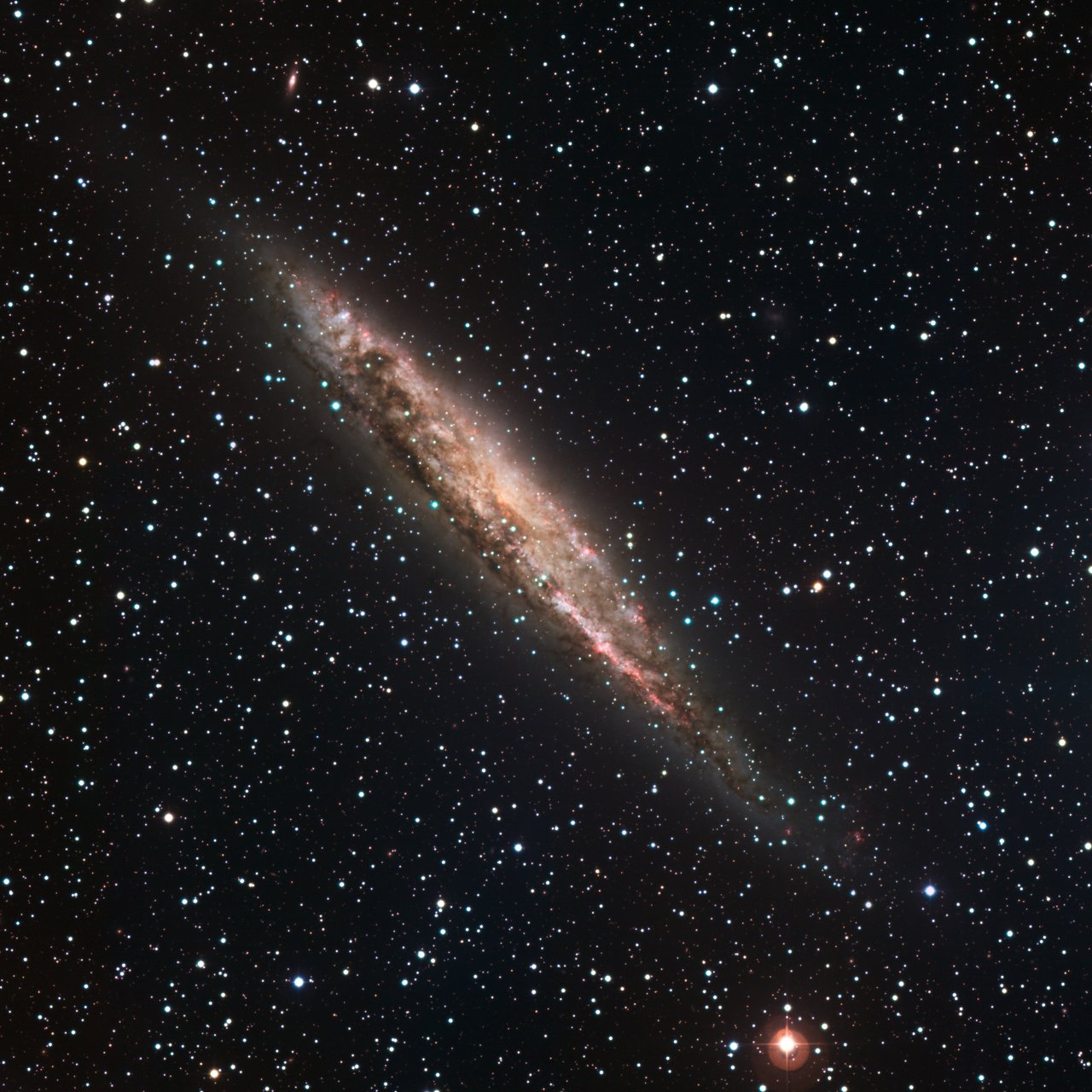 |
|||||||
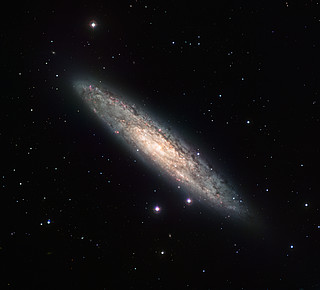
8. (AGE) The Universe is now about 14 billion years old. Our Sun was created within the Universe (inside our Milky Way Galaxy) about 4 billion years ago.. or at a time when the Universe was two thirds of the current age. Our Sun is due to last another 4 billion years.. while the universe is due to last for a trillion, trillion, trillion, trillion, trillion, trillion, trillion, trillion, trillion, trillion, trillion, trillion, trillion (you get the idea here?) MORE YEARS after our Sun disintegrates! All the while producing billions of more Suns throughout billions of more Galaxies inside itself. So you see, the existing Universe, at 14 Billion years old, is only at a tiny, tiny fraction of the age that it will eventually become. 9. (BIG NUMBERS) Humans do not have a good grasp of numbers like a million -let alone a billion , or a trillion . When contemplating a thousand compared to a million, or when comparing a million to a billion, or even a billion to a trillion, keep the following question and its answer, in mind : If on the line below, point A marks (zero) and point B marks 1 billion: with this in mind, ask someone to mark a point somewhere on this line to estimate where they think the number 1 million would reside.
(zero) 0 =
A...............................................................................................B
= (1 billion)
You will find that most
people make the mark for 1 million somewhere near the middle of the
line. But in fact 1
million is merely
a small fraction of 1
billion . To be
exact, a million
is 1/1000th of a billion . This means that the mark on the
line above for 1
million is about
as close to point A as you could get your pencil to mark! (One million would not even exist within the
first dot on the line above.) Try this sometime with a friend. The same
is true for making a line with a trillion, and putting on the mark for
1 billion.. again it would be 1/1000th. Same for one thousand compared
to one million.( place a mark on the line above where you think one million mark would be ? )  10. (IMAGINE YOURSELF
AS
BIG AS THIS UNIVERSAL PERSPECTIVE) Here is a neat way to look at the
stars above. If you were so large a Being that the Sun and the Earth
(including all of the actual space of distance between the two) could
fit in the palm of your hand.. and you then decided to start walking,
with such oversized Being strides (you would be walking 2000 times
faster
than the speed of light!), towards the next Star nearest to our Sun
-you would need to walk for 19 straight hours without stopping through
nearly empty space, before you would reach
your destination to the next
nearest Star. Most of the Stars you see in the night sky from earth,
you would reach in 20-40 years of such walking.. not to mention making
it out
of our own Galaxy!.. to another nearby Galaxy. (For example, at that
rate, would take you about 1,200 years of walking, through empty space
without stopping,
just
to
reach the first galaxy nearest to us! [empty except for some very sparse
ancient
star clusters kicked out of some galaxies]) 10. (IMAGINE YOURSELF
AS
BIG AS THIS UNIVERSAL PERSPECTIVE) Here is a neat way to look at the
stars above. If you were so large a Being that the Sun and the Earth
(including all of the actual space of distance between the two) could
fit in the palm of your hand.. and you then decided to start walking,
with such oversized Being strides (you would be walking 2000 times
faster
than the speed of light!), towards the next Star nearest to our Sun
-you would need to walk for 19 straight hours without stopping through
nearly empty space, before you would reach
your destination to the next
nearest Star. Most of the Stars you see in the night sky from earth,
you would reach in 20-40 years of such walking.. not to mention making
it out
of our own Galaxy!.. to another nearby Galaxy. (For example, at that
rate, would take you about 1,200 years of walking, through empty space
without stopping,
just
to
reach the first galaxy nearest to us! [empty except for some very sparse
ancient
star clusters kicked out of some galaxies])11. (OR IMAGINE THIS, YOU PLAY WITH THE MILKY WAY AS IF IT IS A FLYING DISC TOY!) If you could enlarge yourself enough to hold our whole Milky Way galaxy (all 200 billion stars) in your hand like a frisbee. Indeed it would be shaped just like a frisbee disc, however, it would also be much thinner. To flip the example around for you, I could also say it this way: If you could somehow shrink the entire universe around you, while you stay the same size and the Milky Way galaxy shrinks in front of you down to the size of a frisbee.. and in the process of shrinking it down, you also kept all the relative distances the same for all the stars within the galaxy, then the "miniature galaxy" would be shaped like a frisbee, but would end up being thinner than a piece of paper!  More Interesting is, if
you
were able to hold the Milky Way galaxy in your hand, the nearest galaxy
to
you would be a walk of about 3 months away, and it would fit in your
hand
the same as the Milky Way would. And remember, there are about 250
billion
more galaxies, similar to them. In that relative relationship of size,
if
you were able to hold the galaxy in your hand and start walking from
one
end of the Universe to the other end, it would take you about 1.5 years non-stop.
!
You would have walked past nearly 200 billion gallaxies to get to the
edge. In this calculation, you would be taking steps that span 300,000
light years at a time! You would be taking a step in one second, that
takes light ( traveling at 186,000 miles per second) 300,000 years to
travel! More Interesting is, if
you
were able to hold the Milky Way galaxy in your hand, the nearest galaxy
to
you would be a walk of about 3 months away, and it would fit in your
hand
the same as the Milky Way would. And remember, there are about 250
billion
more galaxies, similar to them. In that relative relationship of size,
if
you were able to hold the galaxy in your hand and start walking from
one
end of the Universe to the other end, it would take you about 1.5 years non-stop.
!
You would have walked past nearly 200 billion gallaxies to get to the
edge. In this calculation, you would be taking steps that span 300,000
light years at a time! You would be taking a step in one second, that
takes light ( traveling at 186,000 miles per second) 300,000 years to
travel!
However, the photo (below), has fixed the problem. Indeed like a see-through-lens, it is a real photo of our Milky Way Galaxy from our position inside it. Our Galaxy! In fact at night, if all the clouds of gas and dust were removed from the space within the galaxy, this (below) is what we would see in our night sky! This picture was taken from our position in the galaxy, with an infra-red camera, which can see the heat and replicate the light through the clouds of dust and gas, and reveal a clear picture of where we are in the galaxy. This is exactly what our galaxy looks like from where we stand in it. Imagine, what all of mankind would have thought over the years, if this (below) is what we saw in the night sky. Imagine seeing the Moon floating amongst that background in the night sky. 
|
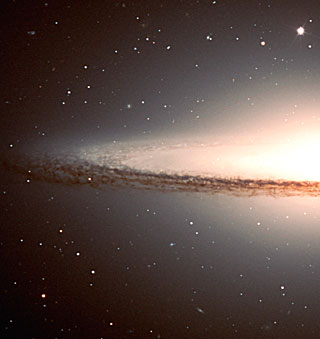
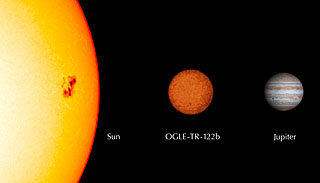
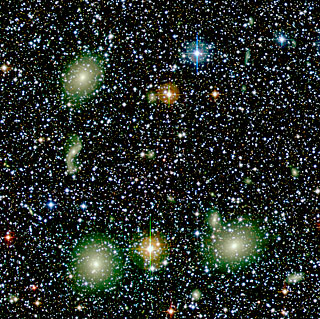
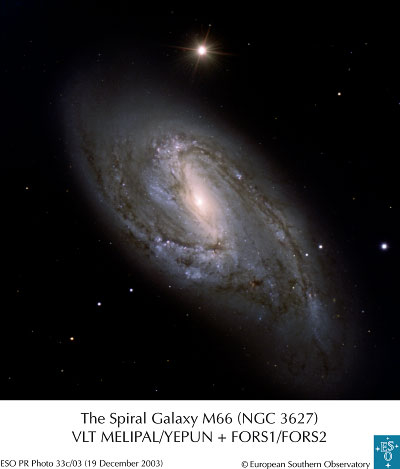


No comments:
Post a Comment